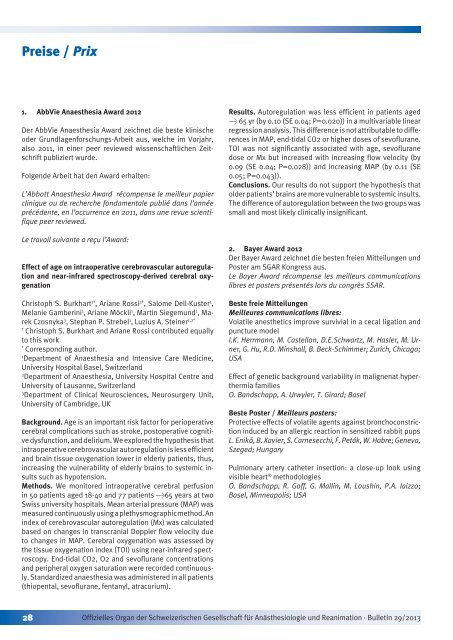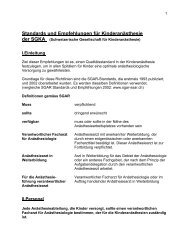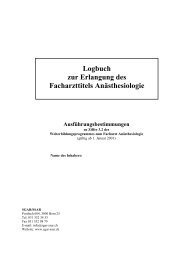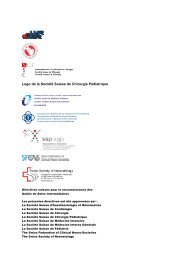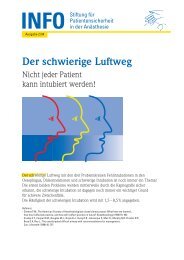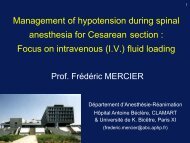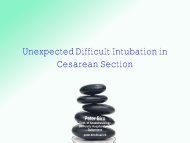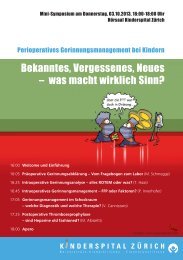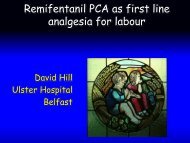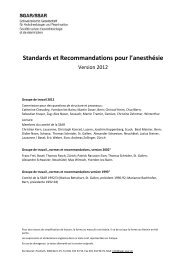Bulletin Nr. 29, April 2013 - Schweizerische Gesellschaft für ...
Bulletin Nr. 29, April 2013 - Schweizerische Gesellschaft für ...
Bulletin Nr. 29, April 2013 - Schweizerische Gesellschaft für ...
You also want an ePaper? Increase the reach of your titles
YUMPU automatically turns print PDFs into web optimized ePapers that Google loves.
Preise / Prix<br />
1. AbbVie Anaesthesia Award 2012<br />
Der AbbVie Anaesthesia Award zeichnet die beste klinische<br />
oder Grundlagenforschungs-Arbeit aus, welche im Vorjahr,<br />
also 2011, in einer peer reviewed wissenschaftlichen Zeitschrift<br />
publiziert wurde.<br />
Folgende Arbeit hat den Award erhalten:<br />
L’Abbott Anaesthesia Award récompense le meilleur papier<br />
clinique ou de recherche fondamentale publié dans l’année<br />
précédente, en l’occurrence en 2011, dans une revue scientifique<br />
peer reviewed.<br />
Le travail suivante a reçu l’Award:<br />
Effect of age on intraoperative cerebrovascular autoregulation<br />
and near-infrared spectroscopy-derived cerebral oxygenation<br />
Christoph S. Burkhart 1† , Ariane Rossi 2† , Salome Dell-Kuster 1 ,<br />
Melanie Gamberini 1 , Ariane Möckli 1 , Martin Siegemund 1 , Marek<br />
Czosnyka 3 , Stephan P. Strebel 1 , Luzius A. Steiner 1,2*<br />
†<br />
Christoph S. Burkhart and Ariane Rossi contributed equally<br />
to this work<br />
*<br />
Corresponding author.<br />
1<br />
Department of Anaesthesia and Intensive Care Medicine,<br />
University Hospital Basel, Switzerland<br />
2<br />
Department of Anaesthesia, University Hospital Centre and<br />
University of Lausanne, Switzerland<br />
3<br />
Department of Clinical Neurosciences, Neurosurgery Unit,<br />
University of Cambridge, UK<br />
Background. Age is an important risk factor for perioperative<br />
cerebral complications such as stroke, postoperative cognitive<br />
dysfunction, and delirium. We explored the hypothesis that<br />
intraoperative cerebrovascular autoregulation is less efficient<br />
and brain tissue oxygenation lower in elderly patients, thus,<br />
increasing the vulnerability of elderly brains to systemic insults<br />
such as hypotension.<br />
Methods. We monitored intraoperative cerebral perfusion<br />
in 50 patients aged 18-40 and 77 patients >65 years at two<br />
Swiss university hospitals. Mean arterial pressure (MAP) was<br />
measured continuously using a plethysmographic method. An<br />
index of cerebrovascular autoregulation (Mx) was calculated<br />
based on changes in transcranial Doppler flow velocity due<br />
to changes in MAP. Cerebral oxygenation was assessed by<br />
the tissue oxygenation index (TOI) using near-infrared spectroscopy.<br />
End-tidal CO2, O2 and sevoflurane concentrations<br />
and peripheral oxygen saturation were recorded continuously.<br />
Standardized anaesthesia was administered in all patients<br />
(thiopental, sevoflurane, fentanyl, atracurium).<br />
Results. Autoregulation was less efficient in patients aged<br />
> 65 yr (by 0.10 (SE 0.04; P=0.020)) in a multivariable linear<br />
regression analysis. This difference is not attributable to differences<br />
in MAP, end-tidal CO2 or higher doses of sevoflurane.<br />
TOI was not significantly associated with age, sevoflurane<br />
dose or Mx but increased with increasing flow velocity (by<br />
0.09 (SE 0.04; P=0.028)) and increasing MAP (by 0.11 (SE<br />
0.05; P=0.043)).<br />
Conclusions. Our results do not support the hypothesis that<br />
older patients’ brains are more vulnerable to systemic insults.<br />
The difference of autoregulation between the two groups was<br />
small and most likely clinically insignificant.<br />
2. Bayer Award 2012<br />
Der Bayer Award zeichnet die besten freien Mitteilungen und<br />
Poster am SGAR Kongress aus.<br />
Le Bayer Award récompense les meilleurs communications<br />
libres et posters présentés lors du congrès SSAR.<br />
Beste freie Mitteilungen<br />
Meilleures communications libres:<br />
Volatile anesthetics improve survivial in a cecal ligation and<br />
puncture model<br />
I.K. Herrmann, M. Castellon, D.E.Schwartz, M. Hasler, M. Urner,<br />
G. Hu, R.D. Minshall, B. Beck-Schimmer; Zurich, Chicago;<br />
USA<br />
Effect of genetic background variability in malignenat hyperthermia<br />
families<br />
O. Bandschapp, A. Urwyler, T. Girard; Basel<br />
Beste Poster / Meilleurs posters:<br />
Protective effects of volatile agents against bronchoconstriction<br />
induced by an allergic reaction in sensitized rabbit pups<br />
L. Enikõ, B. Xavier, S. Carnesecchi, F. Peták, W. Habre; Geneva,<br />
Szeged; Hungary<br />
Pulmonary artery catheter insertion: a close-up look using<br />
visible heart ® methodologies<br />
O. Bandschapp, R. Goff, G. Mallin, M. Loushin, P.A. Iaizzo;<br />
Basel, Minneapolis; USA<br />
28<br />
Offizielles Organ der <strong>Schweizerische</strong>n <strong>Gesellschaft</strong> für Anästhesiologie und Reanimation · <strong>Bulletin</strong> <strong>29</strong>/<strong>2013</strong>


